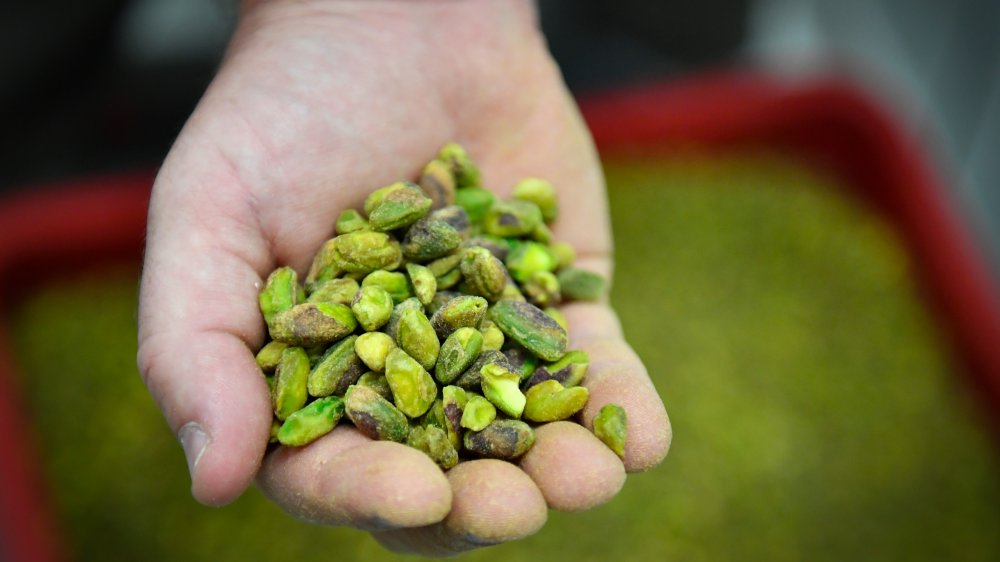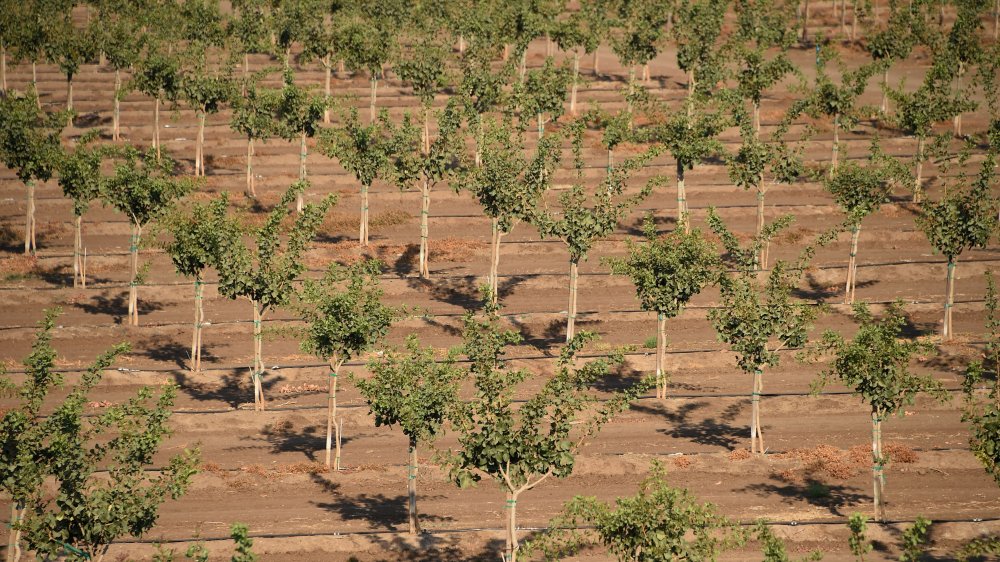Why Are Pistachios So Expensive?
We enjoy it on its own as a snack, as a crunchy topping on fruits and salads, blended into pasta, and as a better-than-respectable stand in for pine nuts in pesto. We bake them into mouthwatering cookies, cakes, and biscotti. We're also blown away by pistachios when they take a star turn in their own ice cream flavor. What is there not to love about this versatile, nutritious, colorful nut?
Answer: its price. In 2018, Money Inc ranked the pistachio as one of the 10 most expensive nuts in the world — even if the pistachio is technically not a nut, it's a seed (via WebMD). It may not have been as pricey as the almond (third most expensive, at $13.99 per pound), pine nut (second most expensive, at $23 per pound), or the eye-wateringly expensive macadamia nut (priciest nut, at $25 per pound), but pistachios rank up there simply because one of the healthiest and most expensive nuts is also one of the most difficult ones to cultivate.
Pistachios have been enjoyed for thousands of years
WebMD says the pistachio tree may have come from western Asia, and that humans may have begun enjoying pistachios as far back as 7,000 BC. While pistachio trees first reached the United States sometime during the mid-1800s, these were not cultivated commercially until the 1970s.
Today, pistachio orchards can be found in California, Arizona, and New Mexico, and the seeds/nuts come in a rainbow of shades that go from yellow to green. Pistachio trees share a gene pool with other plants and produce we're familiar with, including cashew, mango, pepper, and sumac, as well as poison ivy and oak (via Fruit and Nut Research).
Pistachios thrive in difficult conditions
Heart of the Desert says pistachio trees are hardy things that can survive in poor soil, and can be subjected to extreme weather conditions. But they still have a few requirements, one of which is they need adequate root drainage. They love cool winters where they need to spend around a thousand hours under 45F, and where the ground is not likely to freeze.
Pistachio trees also need long, hot summers with low humidity so their kernels can ripen properly. Because these conditions are so specific, it shouldn't be surprising that the pistachio can only grow in specific places around the world. Pistachios are enamored with California in particular (the U.S. produces nearly 39 percent of the world's pistachios) and the Middle East as well (where Iran is the world's second top producer), followed by Turkey, China, and Syria (via Tridge).
Pistachios are difficult to cultivate
Like everything that mother nature produces and that we are in love with, pistachios take forever and a day to cultivate, grow, and bear fruit. A tree needs upwards of five years after it is planted before it can begin to produce a pistachio, and it takes 15 to 20 years from then to reach peak production. Only female pistachio trees get to produce the mouthwatering seeds, and each female can only produce about 40 pounds of dried seeds for every harvest. Fun fact: Male pistachios, also known as pollinators, make up approximately 10 to 15 percent of the total number of trees in any pistachio grove.
As with any other crop, if the weather conditions aren't perfect, the pistachio trees aren't able to do their thing and we end up with a shortage. Also, it takes a while for the female pistachio to gather enough nutrition to produce a crop, so we can only expect pistachio trees to be at their productive peak every other year. During the times the trees are unable to produce, the females gather up their energy and store enough nutrition to take them into the following harvest season.
Pistachios are packed with vitamins and nutrients
While artificial intelligence might be helpful in different aspects of crop production, but it may not fare as well when it comes to monitoring and supervising pistachio harvests. Heart of the Desert says humans are needed to process the nuts, as pistachios need to be hand-sorted so the best get selected and packed for eager fans to enjoy.
Are they worth that much work? You bet they are. WebMD says one serving of pistachios (that's about 49 kernels) has nearly 6 grams of protein, nearly 8 grams of carbs, almost 13 grams of fat, 3 grams of fiber, and are cholesterol-free. Pistachios are also rich in manganese, phosphorus, copper, vitamin B6, and potassium. They have high levels of unsaturated fatty acids and enough potassium to go head-to-head against a large banana — and win. The fiber levels in a 2-ounce serving of pistachio also rival that of a cup of cooked broccoli.
Small wonder, then, that the pistachio is known as the "smiling nut" in Iran and the "happy nut" in China, and why many people feel they are well worth their price (via Self).




